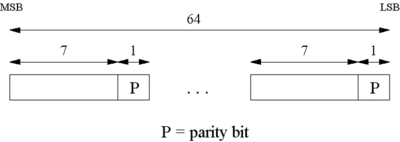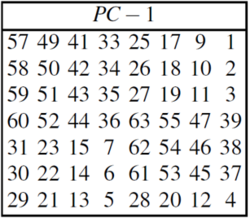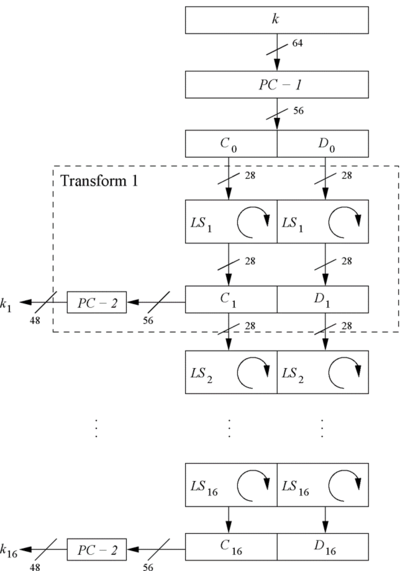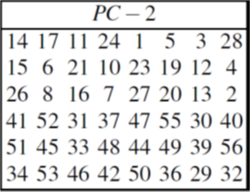(Added youtube links) |
|||
| Line 16: | Line 16: | ||
---- | ---- | ||
---- | ---- | ||
| − | =[ | + | Introduction to Key Schedule by Prof. Paar. |
| − | <youtube> | + | |
| + | =[https://youtu.be/GGtKeWizkaY Link to video on youtube]= | ||
| + | <youtube>https://youtu.be/GGtKeWizkaY</youtube> | ||
---- | ---- | ||
''' | ''' | ||
| Line 33: | Line 35: | ||
[[File:KS1.png|250px|thumb|left|Fig 1b: 64-bit key input bit description]] | [[File:KS1.png|250px|thumb|left|Fig 1b: 64-bit key input bit description]] | ||
| + | =[http://youtu.be/H10mlpjjLAQ Link to video on youtube]= | ||
| + | <youtube>http://youtu.be/H10mlpjjLAQ</youtube> | ||
Step 2: Split the 56-bit Key in two 28-bit halves: Left - <math>C_0</math> and Right - <math>D_0</math>(Refer Fig 2). | Step 2: Split the 56-bit Key in two 28-bit halves: Left - <math>C_0</math> and Right - <math>D_0</math>(Refer Fig 2). | ||
[[File:KS3.png|400px|thumb|left|Fig 2: Key Schedule for DES encryption]] | [[File:KS3.png|400px|thumb|left|Fig 2: Key Schedule for DES encryption]] | ||
| + | |||
| + | =[http://youtu.be/sI1FoqiXix0 Link to video on youtube]= | ||
| + | <youtube>http://youtu.be/sI1FoqiXix0</youtube> | ||
Step 3: With <math>C_0</math> and <math>D_0</math> defined, we now create sixteen blocks <math>C_n</math> and <math>D_n</math>, <math>1≤n≤16</math> using following rules. | Step 3: With <math>C_0</math> and <math>D_0</math> defined, we now create sixteen blocks <math>C_n</math> and <math>D_n</math>, <math>1≤n≤16</math> using following rules. | ||
| Line 46: | Line 53: | ||
[[File:KS4.png|250px|thumb|left|Fig 3: PC-2 Permutation table]] | [[File:KS4.png|250px|thumb|left|Fig 3: PC-2 Permutation table]] | ||
| + | |||
| + | The complete lecture video can be found [https://www.youtube.com/watch?v=l-7YW06BFNs here]. | ||
==== DES Key Schedule - Example ==== | ==== DES Key Schedule - Example ==== | ||
| + | |||
Latest revision as of 05:33, 18 June 2015
DES Key Schedule
A slecture on Cryptography by student Divya Agarwal and Katie Marsh.
Partly based on the Cryptography Summer 2015 lecture material of Prof. Paar.
Introduction to Key Schedule by Prof. Paar.
Contents
Link to video on youtube
Accompanying Lecture Notes
DES Key Schedule - Theory
The DES key schedule genrates 16 round keys (or sub-keys) for the 16 encryption rounds. The sub-keys are derived out of the original 64-bit key given as an input.
Step 1: The original 64-bit key is reduced to 56-bit key using the PC-1 permutation table (Fig 1a). Note: Every 8th bit is ignored in the table(i.e. bits numbered 8, 16, 24, 32, 40, 48, 56, and 64). Nevertheless number the bits from 1 to 64, going left to right(Fig 1b).
Link to video on youtube
Step 2: Split the 56-bit Key in two 28-bit halves: Left - $ C_0 $ and Right - $ D_0 $(Refer Fig 2).
Link to video on youtube
Step 3: With $ C_0 $ and $ D_0 $ defined, we now create sixteen blocks $ C_n $ and $ D_n $, $ 1≤n≤16 $ using following rules.
- In rounds i = 1,2,9,16 , the two halves are each rotated left by one bit.
- In all other rounds, where i ≠ 1,2,9,16 , the two halves are each rotated left by two bits.
- Total number of rotations 4*1 + 12* 2 = 28 which leads to an interesting property : $ C_0 $=$ C_{16} $ and $ D_0 $=$ D_{16} $.
Step 4: We now form the keys $ K_n $, for $ 1≤n≤16 $, by applying the PC-2 permutation table (Fig 3) to each of the concatenated pairs $ C_nD_n $ to generate 48-bit keys out of 56-bit bit $ C_nD_n $.
The complete lecture video can be found here.
DES Key Schedule - Example
References
- C. Paar. Understanding Cryptography. Lecture Notes. Dept. of Electr. Eng. and Information Sciences, Ruhr University.
- C. Paar and J. Pelzl. Understanding Cryptography. A textbook for Student and Practitioners. Springer 2010.
- J. Orlin Grabbe, The DES Algorithm Illustrated.
Questions and comments
If you have any questions, comments, etc. please post them here.
Back to 2015 Summer Cryptography Prof. Paar





